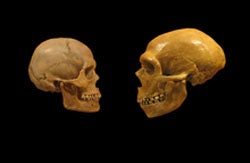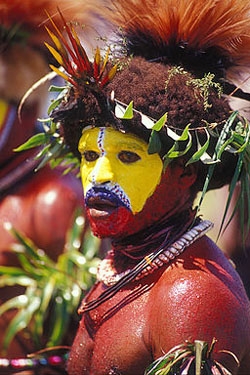show/hide words to know
Neanderthal: An extinct hominin species that was closely related to humans; Neanderthals occupied regions of Europe and the Middle East and went extinct about 35,000 years ago.
Later Homo
He stalks through the tall grass, moving one slow step after another, trying to keep a tree between him and the animal so it does not see him. When he finally reaches the tree, he is close enough to take aim. He raises his spear, moves out from behind the tree, and lunges toward the animal as he throws the spear. It sails through the air and hits the target.
Later members of the Homo genus, including early members of our own species, were expert hunters. Meat was probably a very important part of their diets. Large amounts of meat were ideal energy sources for the growth and maintenance of large brains. Indeed, these hominins had brain sizes similar to modern humans. In fact, some Neanderthals had brain sizes that were even larger than modern humans.
 Modern human brains are about the size of ten tennis balls, whereas Neanderthal brains were about the size of 12 tennis balls. Because Neanderthals had big brains, they were probably very smart. They also had elaborate stone tools and complex social systems.
Modern human brains are about the size of ten tennis balls, whereas Neanderthal brains were about the size of 12 tennis balls. Because Neanderthals had big brains, they were probably very smart. They also had elaborate stone tools and complex social systems.
For example, in Spain, anthropologists found 50,000-year-old shells that belonged to Neanderthals. These shells contained pigment. Pigments can be used for many things, like makeup and painting. This suggests that Neanderthals may have used body art. Using body art is a very human thing to do. Just think about how we use makeup and tattoos to express ourselves. Neanderthals also wore feathers and shells, perhaps as necklaces. There is also evidence that Neanderthals buried their dead, at least some of the time. All of these complex behaviors are probably due to large brains.
Huli wigman from Papua New Guinea. This Huli man shows how modern human societies might use paint and feathers to decorate their bodies for ritual purposes. Image by Nomadtales.









